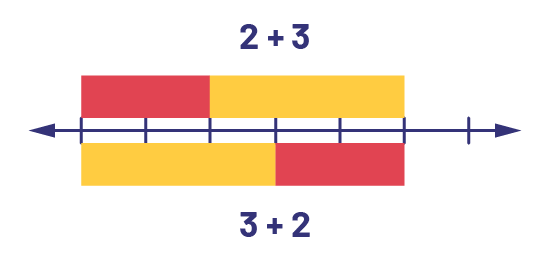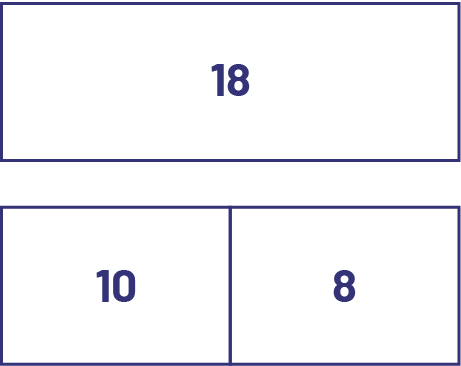B2.1 Use the properties of addition and subtraction, and the relationships between addition and multiplication and between subtraction and division, to solve problems and check calculations.
Skill: Use the Properties of Addition and Subtraction to Solve Problems and Check Ccalculations
In the primary grades, students make connections between operations through various activities. For example, they learn about the identity rule, that addition and subtraction are inverse operations and that addition is commutative. Over time, students develop their number and operations sense and gradually use them before performing operations. This practice, while often informal and mental, is essential to understanding the relationships between numbers and between operations.
Source: translated from Guide d’enseignement efficace des mathématiques de la 4e à la 6e année, Numération et sens du nombre, Fascicule 1, Nombres naturels, p. 97.
It is not necessary for primary students to know the names of the properties. The goal is to get them to use them naturally to combine numbers.
Students demonstrate their understanding of the properties of mathematical operations when they use concrete materials, drawings, words, or symbols to represent mathematical ideas and relationships.
Source: translated from Guide d'enseignement efficace des mathématiques de la maternelle à la 3e année, p. 17.
The properties of addition are:
- commutative property (for example, \(1 + 2 = 2 + 1\));
- associative property (for example, \((8 + 9) + 2 = 8 + (9 + 2)\));
- identity property (for example, \(1 + 0 = 1\)).
The property of subtraction is:
- the identity property (for example, 1 - 0 = 1).
Source: translated from Guide d’enseignement efficace des mathématiques de la 1re à la 3e année, Numération et sens du nombre, p. 33.
Commutative Property
Students who recognize the commutative property of addition can reduce the amount of math facts they need to learn in half. Visual representation of facts such as (3 + 2) and (2 + 3) helps students grasp this relationship.
Source: translated from Guide d’enseignement efficace des mathématiques de la maternelle à la 6e année, Fascicule 5, p. 19.

Associative Property
The associative property allows the terms of an expression to be combined in different ways without changing the value; for example, in the expression \(15 + 13 + 17\), it is possible to combine 13 and 17 to get \(15 + (13 + 17)\), which gives \(15 + 30\), or 45. It is also possible to combine 15 and 13 to get (\(15 + 13) + 17\), which gives \(28 + 17\), or 45.
The associative property does not change the order of numbers in a numerical expression. However, associativity and commutativity can be combined to facilitate the evaluation of a numerical expression. To determine the value of the expression \(19 + 27 + 11\), we can determine the value of \((19 + 11) + 27\), because the 9 and the 1 are complementary and give a ten, so we can more easily compute mentally, as \(30 + 27\). By exposing students to a wide range of activities, the teacher can help them understand and use the different properties effectively.
Source: translated from Guide d'enseignement efficace des mathématiques de la 4e à la 6e année, Numération et sens du nombre, Fascicule 1, Nombres naturels, p. 105-107.
Important!
Parentheses are used to ensure mathematical accuracy. However, with Grade 2 students, it is best to use less abstract ways of highlighting combinations; for example:

Source: translated from Guide d'enseignement efficace des mathématiques de la maternelle à la 3e année, Modélisation et algèbre, Fascicule 2, Situations d'égalité, p. 98.
Identity Property
When using the identity property, encourage students to propose conjectures such as, "If I add zero to a quantity (for example, \(5 + 0\)), that quantity stays the same and if I add any quantity to 0 (for example, \(0 + 5\)), I get the quantity that I added.
By applying these conjectures to different numbers, students will be able to formulate a generalization that this property is true for all numbers.
For the identity property in subtraction, encourage students to propose a conjecture such as, "When I subtract 0 from a number (for example, \(5 - 0\)), I get the starting number." By applying this conjecture to different numbers, students will be able to make a generalization that this property is true for all numbers.
Source: translated from Guide d'enseignement efficace des mathématiques de la maternelle à la 3e année, Modélisation et algèbre, Fascicule 2, Situations d'égalité, p. 93 and 95.
Skill: Using the Relationship Between Addition and Subtraction to Solve Problems and Check Calculations
Addition and Subtraction
Understanding the connections between operations (for example, addition and subtraction are inverse operations) supports students in learning basic number facts and solving problems.
Source: translated from Guide d’enseignement efficace des mathématiques de la 1re à la 3e année, Numération et sens du nombre, p. 32.
Addition and subtraction are inverse operations. Students who are learning often have difficulty solving equations such as (17 + ? = 31). Many teachers encourage them to use the inverse operation, subtraction. However, this can just be a trick that students may forget unless they understand why subtraction is a possible strategy to find the missing term. To do this, they must first grasp the relationship of the whole to its parts and the meaning of a difference; for example, a number can be represented as:

This way of representing the relationship between a number and its parts allows us to see that subtraction is the inverse operation of addition. Thus, since 10 + 8 = 18 and 8 + 10 = 18, then 18 - 10 = 8 and 18 - 8 = 10. In addition, students can understand why addition is commutative (\(10 + 8 = 8 + 10)\) and subtraction is not (\(18 - 10 ≠ 10 - 8\)). Students who have developed good number sense and are able to decompose and combine numbers can use their knowledge to more effectively solve equations such as \(10 + \mathord{?} = 18\) by understanding that we are looking for the difference between 10 and 18.
Source: translated from Guide d’enseignement efficace des mathématiques de la 4e à la 6e année, Numération et sens du nombre, Fascicule 1, Nombres naturels, p. 93 and 95.
Multiplication and Addition
The connection between multiplication and addition is often the starting point for introducing students to the concept of multiplication. Early in learning multiplication, students recognize that the situation presents the same quantity "many times" and use equal groups to represent the situation and repeated addition to get the answer.
Source: translated from Guide d’enseignement efficace des mathématiques de la 4e à la 6e année, Numération et sens du nombre, Fascicule 1, Nombres naturels, p. 85.
Since multiplication can be seen as repeated addition (for example, 3 x 5 = 5 + 5 + 5 or three 5s), students can relate the doubles strategy (for example, 4 + 4 = 8) to multiplication by two. The connections between addition and multiplication can also support students to learn some basic math facts; for example, a student who knows that 3 x 4 = 12 can reason that 4 x 4 = 16, since 4 x 4 = 16 is equivalent to 3 x 4 + 4 more, which is 16.
Source: translated from Guide d’enseignement efficace des mathématiques de la 1re à la 3e année, Numération et sens du nombre, p. 32.
By solving a variety of problems and discussing strategies, students come to make and understand the connection between the word "times" and the sign "times", a crucial step in developing an understanding of multiplication. Once their sense of multiplication is well established, they will use the multiplication operation more regularly to obtain answers.
Source: translated from Guide d’enseignement efficace des mathématiques de la 4e à la 6e année, Numération et sens du nombre, Fascicule 1, Nombres naturels, p. 86.
Division and Subtraction
Similarly, division can be associated with repeated subtraction. The product of a multiplication is equal to the sum resulting from the repeated addition, while the quotient of a division is equal to the number of repeated subtractions that can be taken from the dividend (for example, to calculate \(20\; \div \;5\ \), we do \(20\; - \;5\; = \;15,\;15\; - \;5\; = \;10,\;10\; - \;5\; = \; 5,\;5\; - \;5\; = \;0\); we subtracted 4 times; therefore \(20\; \div \;5\; = \;4\)).
Source: translated from Guide d’enseignement efficace des mathématiques de la 4e à la 6e année, Numération et sens du nombre, Fascicule 1, Nombres naturels, p. 98-99.
Division can be seen as repeated subtraction or addition (for example, \(24 - 4 - 4 - 4 - 4 - 4 - 4 = 0\), so taking away 6 groups of 4 from 24 results in 0 or \(4 + 4 + 4 + 4 + 4 + 4 = 24\), so adding 6 groups of 4 results in 24) or as dividing into equal parts.
Source: translated from Guide d’enseignement efficace des mathématiques de la 1re à la 3e année, Numération et sens du nombre, p. 32.
It takes time for students to learn these relationships. To achieve this, teachers can use hands-on activities, problem solving, and mathematical exchanges that focus on the connections between operations.
Knowledge: Commutative Property
An operation is commutative if its result remains unchanged when the order of its terms is reversed. For example, addition is commutative. However, subtraction is not a commutative operation.
Example
\(2 + 3 = 3 + 2\)
\(6 - 3 ≠ 3 - 6\)
Source: translated from Guide d’enseignement efficace des mathématiques de la 4e à la 6e année, Numération et sens du nombre, Fascicule 1, Nombres naturels, p.102.
Knowledge: Associative Property
The associative property is a property of addition and multiplication. It allows the terms of an expression to be combined in different ways without changing their value.
Knowledge: The Identity Property
The identity property occurs when a number is combined with a special number (identity element) by using one of the operations, and the result leaves the original number unchanged. In addition, and subtraction, the identity element is 0; for example, for example, \(7 + 0 = 7\) and \(0 + 7 = 7\).
Source: translated from Guide d’enseignement efficace des mathématiques de la 4e à la 6e année, Numération et sens du nombre, Fascicule 1, Nombres naturels, p.105-107.
Knowledge: Relationships Between Addition, Subtraction, Multiplication and Division
Addition and subtraction are inverse operations.
Multiplication can be associated with repeated addition.
Division can be associated with repeated subtraction.
